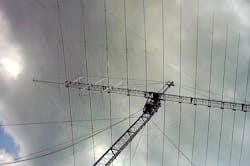Systems & Technology Research joins Leidos in IARPA HF SIGINT signal-processing project
Officials of the U.S. Intelligence Advanced Research Projects Activity (IARPA) in Washington announced an $7.2 million contract to STR last week for the second and third phases of the IARPA High Frequency Geolocation and Characterization (HFGeo) Advanced HF Signal Processing program.
STR joins Leidos Inc. in Reston, Va., on the second and third phases of the HFGeo program. Leidos won an $18.7 million contract for HFGeo phases two and three on 25 Sept.
Many RF signals, such as VHF and UHF, are relatively easy to locate because they travel only in straight lines, and cannot easily penetrate barriers such as tall buildings and mountain ranges. HF radio signals behave in a more complex manner and are much more difficult to locate.
HF radio waves not only follow line-of-sight paths, but they also bounce off of layers Earth's upper atmosphere called the ionosphere and come back to the Earth's surface where antennas tuned to HF frequencies -- roughly 2 to 30 MHz -- can pick them up.
HF signals particularly are prone to interference because antennas literally can receive their signals from different directions and at different times because of the ionospheric bounce phenomenon. The ionosphere is ionized by solar radiation and helps propagate HF radio signals to distant locations, hence the long distances that shortwave and Ham HF radio signals can travel.
Awarding the contracts on behalf of IARPA were officials of the U.S. Air Force Research Laboratory (AFRL) at Wright-Patterson Air Force Base, Ohio. IARPA is the research arm of the Office of the Director of National Intelligence in Washington.
The first phase of the HFGeo program focused on the ability to resolve multiple angles-of-arrival and polarization states through new antenna concepts; the ability to enhance signal-to-noise ratio and signal detection with multi-dimensional adaptive signal processing; and determining the dynamic state of the ionosphere.
The 18-month second phase includes a non-real-time field test of a prototype system and off-line signal processing. The 15-month third phase will involve real-time signal processing, and demonstration with field testing against realistic targets in realistic environments.
The IARPA HFGeo program seeks to geolocate and characterize HF emissions accurately. Ionospheric variation,high noise levels, and ionospheric polarization rotation, multipath induced signal fading, and simultaneous multiple angles-of-arrival.
IARPA officials are asking STR and Leidos engineers to capitalize on advances in high-dynamic-range receivers, antenna techniques, adaptive signal processing, ionospheric ray path prediction, and improved measurement and modeling techniques to geolocate HF emitters around the world, as well as determine if these signals are involved with benign commercial activity, or are part of hostile communications and radar systems.
The goals of the IARPA HFGeo program include developing the ability to resolve several angles-of-arrival and polarization states accurately through novel antenna concepts; enhance signal-to-noise ratio and signal detection with multi-dimensional adaptive signal processing; determine the state of the ionosphere accurately; and integrate these technologies into geolocation and source characterization applications.
For more information contact Systems & Technology Research online at www.stresearch.com, Leidos at www.leidos.com, IARPA at www.iarpa.gov, or the Air Force Research Laboratory at www.wpafb.af.mil/AFRL.
